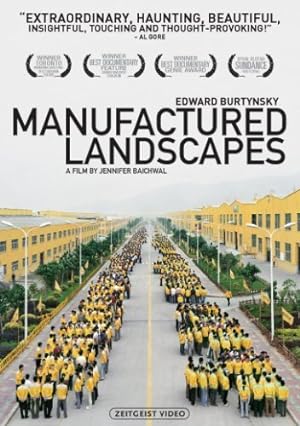After I saw Watermark, which I savored two times to fully appreciate it, I put Manufactured Landscapes in my queue because it had the same director, Jennifer Baichwal, and followed the same artist, Edward Burtynsky, a photographer. Watermark helped me look at the world in a new way. Watermark was released subsequent to Manufactured Landscapes so it isn’t surprising that Watermark is better than its antecedent. My only regret is that mom joined me in watching Manufactured Landscapes, not Watermark.
Manufactured Landscapes is a documentary that shows the impact of man on the environment, but predominantly focuses on China as a place, “where all the materials coalesce.” China is the birthplace and cemetery for modernity although recent news shows that prosperity is beginning to make China resign its position as the final stop for recycled goods. This topic is too broad to lend itself to the similar documentary approach Bauchwal took in Watermark—long visual meditations on the unfamiliar suddenly becoming familiar as the scope of our visual context broadened. Watermark formed a nascent narrative that gradually developed in proportion to viewer’s attention whereas this documentary’s restricted location focus robs it of its impact as “evidence of accumulated taking.” This kind of industrialization of the landscape occurs everywhere, but the restriction to one or two locations in the third world can inadvertently lead to the wrong message as if the Western World did not start the fire.
Manufactured Landscapes felt more like a memoir of his time in China and a meditation on his work since Burtynsky provides more narrative in this documentary than I recall in Watermark. He states, “By not saying what you should see, that may allow them to look at something they never looked at and to see their world a little differently. So I think many people today sit in that uncomfortable spot where, you know, we don’t necessarily want to give up what we have, but we realizr that what we’re doing is creating problems that run deep. It isn’t a simple right or wrong. It needs a whole [new] way of thinking.” Burtynsky’s explanation of his mission statement seems to completely overlap with Baichwal’s, but by including Burtynsky’s words, it actual acts against what they want—for us to come to our own conclusions.
Manufactured Landscapes knows that it has to include a moment of government censorship putting a stop to the synergy of commercial promotion of industry and art due to the threat of exposure of environmental collapse. This documentary just can’t stay neutral, no matter how hard it explicitly tries to be, and suffers the temptations of a journalist with a hot mic. We get to hear factory supervisors’ hector their workers for not being productive enough. It sounds less like communism and more like fascism. The documentary actually becomes a moment of nostalgia for the old ways that man impacted environment as opposed to the large scale destruction of places and people. There is something perverse about being paid to take your home apart.
Manufactured Landscapes’ interplay of his work in the field and at the gallery was just as cleverly and perhaps more saucily interwoven as it was in Watermark. For example, it took me a moment to realize that we were no longer watching the moving footage and the people in it, but seeing a photograph in the gallery until a person moved in the foreground. Combined with the narration, it felt more like a feature length behind the scenes special feature than a documentary that can stand independently on its own from its accompanying publication.
The use of color and black and white was provocative, but I don’t think that I ascertained the true meaning or logic behind the film’s shifting choice. At one point, when the landscape gets disturbed, and dust rises, it changes from black and white to color. It could not be an accident that factories mimic nature by using green, as shown in the long panning shot at the beginning. It is later confirmed when we see a mural of yellow and green sunflowers. The workers’ uniforms are yellow. For factories, it seems more important that factories and workers’ uniforms match rather than reference nature.
Manufactured Landscapes features a smaller vignette about the life cycle of oil from the ground to the waste from a grounded ship, but not necessarily in chronological order. While it was haunting, it felt as if it deserved its own documentary, but didn’t quite fit in this documentary, which largely focused on China and the creation and disposal of consumer goods, and its effect on people and places.
Manufactured Landscapes’ DVD had an unexpected problem. I enjoy watching movies and television shows with subtitles. It is usually sufficient to simply check off English, but there were two different English subtitle options. I could be mistaken, but it was not possibly to simultaneously get English subtitles of what the English speakers were saying simultaneously with English subtitles of a proper transcription of the interpretation of what the Mandarin and Cantonese speakers were saying so I had to rewind and toggle back and forth between options to satisfy my viewing predilection. It isn’t the first time that I encountered this problem, but it did take me awhile to recognize that it was happening so I had to rewind and rewatch the beginning.
I enjoyed Manufactured Landscapes, but unless you’re a fan of Baichal and Burtynsky’s work or are very interest in the subject, I think that this documentary is too challenging for those who won’t be satisfied with allowing images to wash over you without a more conventional narrative. If you want to be challenged, but walk away feeling satisfied, I think that Watermark is the better choice.
Stay In The Know
Join my mailing list to get updates about recent reviews, upcoming speaking engagements, and film news.





